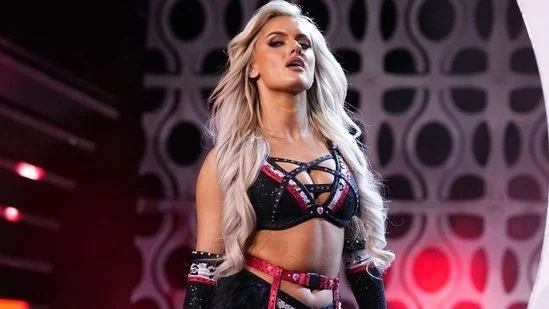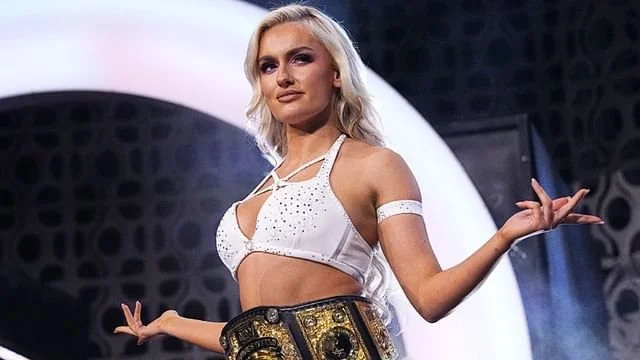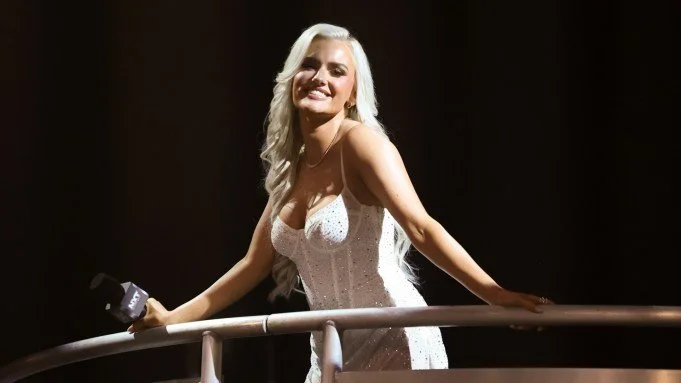Good Breakup: Mariah May’s Exit from AEW
Mariah May has made her WWE NXT debut after leaving AEW, and I can’t help but want The Glamour to achieve her dream. I write that as a fan and writer whose passion and love for AEW is immense. Not every fan will likewise feel the same. For some fans, things are still fresh.
When a wrestler leaves a promotion, some fans do treat it personally.
Like it’s a break-up.
As if a wrestler leaving somehow impacts their sense of identity because they left their preferred company. Yet women in wrestling usually get it worse. There’s a history of women transferring between WWE and AEW who get discussed like game pieces in the inter-promotional war. For example, the outpouring of misogyny and the tearing down of wrestlers like former NXT prospect Elayna Black. May’s received some similar treatment that sees fans invoking the worst aspects of the parasocial relationship. A sense of ownership, entitlement, or, at worst, believing they know the people, while speaking of them as objects.
In many ways, Mariah May’s exit from AEW, compared to some of her recent male counterparts who left AEW, was a good breakup. * **
*Note: Perceptions could change. It just takes an interview, words taken in/or out of context, to spark shock, tribalism, and strong opinions.
**- I’m self-aware of the irony and limitations of comparing a business relationship to a personal relationship. Yet the extended metaphor feels appropriate to the wider issue of how some fans treat and discuss women in wrestling…
Territory Analogy Limits- It’s Personal, Not Business
I could use the territory analogy that others have used. It’s got truth. May came in, got pushed, and put the top star of the territory over. Got paid and moved on. Thanks and bye. Good business.
The issue isn’t how mainstream wrestling works with WWE’s continual threat to try and monopolize the industry once again. It seems more applicable, but it’s somewhat nostalgic and idealised. Hints at glory days and something that doesn’t fit the current wrestling context because we can’t go back to it. Partly because that’s not how wrestling culture works anymore, or even necessarily what wrestlers today want. Or what even all fans want. Or that even worked for everyone, just those rising or top stars.
May and AEW left one another in a better place than before. This is an ideal way of doing business, fulfilling the contract and moving on. It’s a rare example where both received near equal benefits. Rarely are strong emotions not involved. After all, we are talking about someone’s life, their dreams.
It is an actual relationship that wrestlers have with a company, their bosses, their work colleagues, culture, and us, the fandom. It is personal.
Even when someone like May does everything in the perceived right way. Or someone like Elayna Black apparently does something wrong. Like starting an OnlyFans account or highlighting body shaming in her previous work environment.
I mention Black again, not to provide a direct foil. Especially not to suggest Black’s WWE exit was therefore “bad”. Instead, to demonstrate whether you focus on the commodity being their body of work or their physical aesthetic bodies, the limits of those relationships can get blurred in the minds of the wrestling industry and fans.
Narratives
It’s a rare situation where both Mariah May and AEW, at least in appearances and in the kayfabe world of All Elite, left things better than they found them. Blimey, the line between playful banter and actual disdain for guys like Miro or Malakai Black returning to WWE with the perception they saw AEW as a stopgap stirred pots and rattled cages.
The growth of The Glamour and AEW’s women’s division was mutual and coinciding. However, mythmaking has already begun. Yet minimizing and exaggeration, and that’s only likely to continue.
It’s wrestling. Everything is about perceptions and story. Again, breakup-like. Each side narrativizes their experiences.
The problem with such storytelling is that it’s easy for either side or their supporters to claim virtues and give scorn to each other. So, I want to consider the joint and individual successes and weaknesses of both. Neither May nor AEW achieved anything alone. AEW’s women’s revolution did not end in Hollywood. Likewise, Mariah May isn’t the finished product. Her fate isn’t sealed.
Let’s cut through and look at Mariah May’s strengths and limitations of Mariah May’s AEW run.
Star Maker, Ground Breaker
Mariah May came to AEW from Stardom and was instantly foreshadowed as a star of the future. Unlike other new women, rather than debuting in matches to be squashed and beaten before eventually gaining moments and wins once the crowd began to understand who they are. Instead, we were given a story.
One that, from the first moments, hinted at the classic WWE storyline between Mickie James and Trish Stratus, with James as an admirer and a dedicated fan of the superstar Stratus. Little did we know it was going to break ground in terms of LGBT representation, the female gaze and women’s wrestling.
It told us there was a plan. May had a role not just on the card but in the fiction. While “Timeless” Toni Storm is now illuminated and basking in the glow of her star power, let’s not forget it took time getting there. As I wrote when analysing Storm’s development, Mariah May was the anchor that kept Storm grounded and floating away into obscurity. This foreshadowing of a student usurpation helped fans buy in during a time when dislike towards AEW’s sport entertainment-leaning creative was high.
Without May as a protégé and that promise of something good, the Timeless character could have expired before finding her glow. May provided the reason to be patient. May made Storm as much of a star as the other way around, to an extent.
Storm was not the only benefactor. If not for May, would AEW fans have such an appreciation for Mina Shirakawa? Although split, the fact that Shirakawa was in our lives was another significant part of that relationship. Getting to see a continuation of the sapphic love dynamic between Shirakawa and Storm would not exist without May.
Without May also we would not have pushed to the forefront of national western women’s wrestling a LGBT storyline that didn’t put male gratification and pleasure first. Sisters were doing it for themselves.
It’s a strong, impressive, and short legacy to leave. Found memories. But May was not perfect, like any human being.
More Than Glamour?
If there was a limitation to Mariah May’s run, it’s perhaps similar to that of the Lucha Brothers, Rey Fenix and Penta’s AEW runs in that one rivalry will define their peaks. Whereas The Lucha Brothers made the perfect foils to The Young Bucks, Mariah May will always be defined as the other half of The Hollywood Ending.
At the time, I wrote about how Mariah May’s AEW run suffered due to a spotlight issue. Inevitably, we were waiting for Storm to return. May spun her wheels following the pattern of previous AEW Women’s World Champions in a series of predictable short feuds. Only against Shirakawa was there a deeper layer of emotion, or a characterisation not built on a Mariah May is a stone-cold calculation femme fatale. As perfect as May played the role, it lacked the substance or depth of Storm. Or the crowd-connection that others like Kris Statlander or Willow Nightingale evoke.
Feuds against Nightingale, Thunder Rosa, and Anna Jay were creatively let down because they appeared to be stop gaps. There was no characterisation or emotional reason to invest or assume AEW’s wider booking pattern of women’s champions would be disrupted.
The latter was AEW’s fault in terms of booking and marginalisation. The former, May’s characterisation without Storm being the one-dimensional put-down superior heel champion was a stiletto May held to her throat. While May could have been given more time, what she did with it was from a heightened and more sexualised version of WWE’s playbook of female heel archetypes.
The Glamour has a ceiling. If May stayed in AEW, there was potential to follow up with Shirakawa. Yet, eventually, the risk of character stagnation or eventual re-invention would set in sooner or later, as it does for all wrestlers. We’ll never know this was May’s ceiling in AEW. But then never say never…
End of the day, it wasn’t what May wanted, and that’s fine.
Both gained in the short and long term. Both AEW and May have changed for the better.
The Dream- Live It? Wake Up? Move On?
Being in the fed was always Mariah May’s dream. In her representation and character, that inspiration was always clear to see. I’ll acknowledge that recency and hindsight bias are perhaps at work. However, May’s characterisation and presentation, compared to the method acting of Storm or the genuineness of Nightingale, May’s mask was impressive, but more fitting of WWE’s less is always more.
Then again, May is still extremely young and has not reached her first wrestling prime. Not yet. Everyone has expectations. Fans and wrestlers alike. Transitioning from WWE to AEW and vice versa comes with high expectations and lots of unforeseen context, factors, and consequences.
Time will show whether WWE remains the living dream for May. For others, they wake up finding it wasn’t what they expected or wanted. Mercedes Mone and Toni Storm are prime examples. Whether WWE can top the debut and start AEW gave May will be seen. Like with Miro/Rusev’s return, failure to replicate or equal May’s AEW run might push the pendulum back into AEW’s favour.
If things don’t work out, the good thing, in theory, about a good breakup is that the past relationship remains part of your support network. With time, if needed, they can try things again. Get those unanswered questions answered. Or try new things. The same goes for AEW, who now have Shirakawa and Thekla, Megan Bayne, etc..
Life is going to go on. Narratives will get told. Interpretations were written and changed. Fans are going to think what they think. The wrestlers live their dreams and make their choices. Even with our parasocial relationships, we make choices.
Art by Neon Ghost




